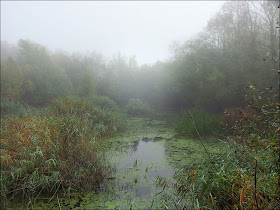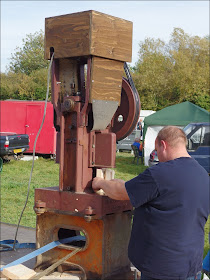I awoke this morning to thick fog clamped down upon the land. But early on patches of watery sunlight started to break up the greyness. Down by the River Ouse in Little Paxton though the fog lingered on deep into the morning.
It's pleasant enough walking here even with reduced visibility. There's a lot of birds out there somewhere and maybe we'll see some later, but at present we'll have to make do with the honks of the geese filtering through the gloom.
If this looks like a natural landscape then think again: the ground here has been browsed, plundered, dug over, built upon and burrowed into by the busiest little animal ever to walk the earth - that endlessly destructive and infinitely creative creature, the human being. Search England all over and you won't find any areas that are untouched by human presence or past endeavour.
The ponds and lakes here all result from the excavation of gravel and sand to be used for building. But now it's returned to nature, a state of affairs for which many human agencies like to take credit but which could not have been attained without the co-operation and resilience of Nature herself.
There's nothing exceptional in this; in England we even have a National Park that has been formed by mankind's digging and delving - the Norfolk Broads are entirely the result of peat-digging during the medieval period. Well, medieval peat-digging and six-hundred years of natural re-colonisation.
Maybe this is the way we should be thinking these days. It's all very laudable to set aside wilderness areas, but that shouldn't give us licence to then destroy everything else with impunity. Maybe we should be declaring the whole nation as a national park and take care of it all. Why not? As I mentioned earlier we are not only the most destructive species ever, we are also the most creative. We are responsible for symphonies, great art, temples, cathedrals, worldwide charities, digital technology......
Surely it should be possible to live alongside nature without destroying it. All the arguments seem to have been made, now it remains to be seen whether we do anything about it.
There was a time when I used to travel all over Europe and even into North Africa in search of beautiful photographs. It wasn't difficult to find them, but in the process I was leaving a dirty great carbon footprint, though no one spoke in those terms back then. Nowadays I'm content to wander around in the fog peering at spiders' webs - now, they must be there all the time but, until the fog highlights them, they go unnoticed.
So for now we'll wander on in the foggy, foggy dew, noticing the little details and doing my best not to tread on too many while taking my photos.
But slowly it seems to be brightening up with occasional sunbeams breaking through. This area is also slowly becoming a better place to be a bird-watcher - and of course a bird! These old gravel pits in the Ouse valley are but a part of the jigsaw.
The Great Fen Project based around Holme Fen is attempting to return 9,000 acres (3,700 hectares) back to its natural state. The National Trust has plans to create an reserve of 13,000 acres (5,300 hectares) to the NE of Cambridge by 2099. The RSPB has created a reedbed of 740 acres at Lakenheath which has already attracted breeding Bitterns and Cranes. Then there's the Ouse Washes and Grafham Water reservoir, both of which attract birdlife even if not specifically designed for that purpose. There are also several farms in the area which are working on more eco-friendly ways to farm.
In the interest of fairness and balance I should also say that contractors are making an incredible mess while widening the A14 road, there are big building projects at Eddington and Northstowe, and Cambridge is growing rapidly itself. So not everything is rosy by a long way.
So what birds are here today now that the mists have cleared?
Grey Heron, Little Egret, Great White Egret, Cormorant, Great Crested Grebe, Mallard, Tufted Duck, Shoveler, Wigeon, Gadwall, Black-Headed Gull, Green Sandpiper, Moorhen, Great Tit, Chaffinch, Wren, Dunnock, Blackbird, Wood Pigeon, Collared Dove, Pheasant, Chaffinch, Long-Tailed Tit, Jay, Magpie, Rook, Greylag Goose, Canada Goose.
Take care.


























































